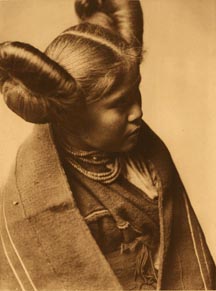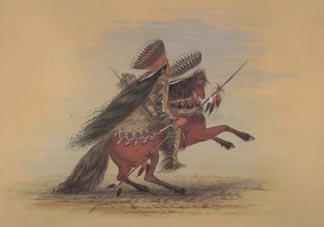'Vanished Worlds, Enduring People' -- Cornell's Native American Collection goes on display
By Franklin Crawford

Starting Friday, Oct. 21, visitors to the Carl A. Kroch Library's Hirshland Gallery will get to view "Vanished Worlds, Enduring People," a premier exhibit featuring one of the nation's most distinguished compilations of materials on the history of the native peoples of North and South America.
The Cornell University Native American Collection, acquired just last year from the Huntington Free Library, is the source of the exhibit, to be displayed through June 2006. Hirshland Gallery hours are 9 a.m. to 5 p.m. Monday to Friday, and Saturdays from 1 to 5 p.m. when classes are in session. The exhibition, presented with support from Evalyn Milman '60 and Stephen Milman '58, also will available online at http://nac.library.cornell.edu.
Among the items in the display are illustrations of native communities and leaders, documents that preserve native languages, early accounts of encounters between European explorers and indigenous peoples, captivity narratives and historical records of tribal communities. The exhibition also includes the manuscripts of prominent anthropologists and those who fought for native rights.
"Vanished Worlds, Enduring People" highlights the great range and depth of the Native American Collection and reaffirms Cornell's commitment to dialogue and education focused on native cultures.

With more than 40,000 volumes and thousands of manuscripts on the aboriginal peoples of the Western Hemisphere, the collection is now the centerpiece of the library's extensive holdings on American Indians. The wide array of documents support inquiry into almost any topic relating to indigenous peoples, from the pre-contact era to the present day, and spans the hemisphere from the Arctic Circle to the southern tip of South America.
The core of the Huntington collection was formed in the early 1900s when George Heye, founder and director of the Museum of the American Indian, acquired the private libraries of two renowned anthropologists, Frederick W. Hodge and Marshall H. Saville. In 1930 the museum transferred its Native American book collection to the Huntington Free Library and Reading Room in the Bronx. The collection grew over the next 70 years as the Huntington library added materials donated by scholars, collectors and others committed to the preservation of American Indian history. In May 2004 the Huntington Free Library's board of directors voted to transfer the collection to Cornell, where it would be better cared for and made more accessible for students, researchers and the Native American community.
Free performance by Ulali:
The public is invited to attend a free performance by Ulali, the Native American women's a cappella group, Thursday, Nov. 3, from 5 to 7 p.m. in the Hirshland Exhibition Gallery, level 2B of the Carl A. Kroch Library. The event celebrates the opening of "Vanished Worlds, Enduring People" and includes a public reception. For more information, call (607) 255-3530 or e-mail rareref@cornell.edu.
Media Contact
Get Cornell news delivered right to your inbox.
Subscribe